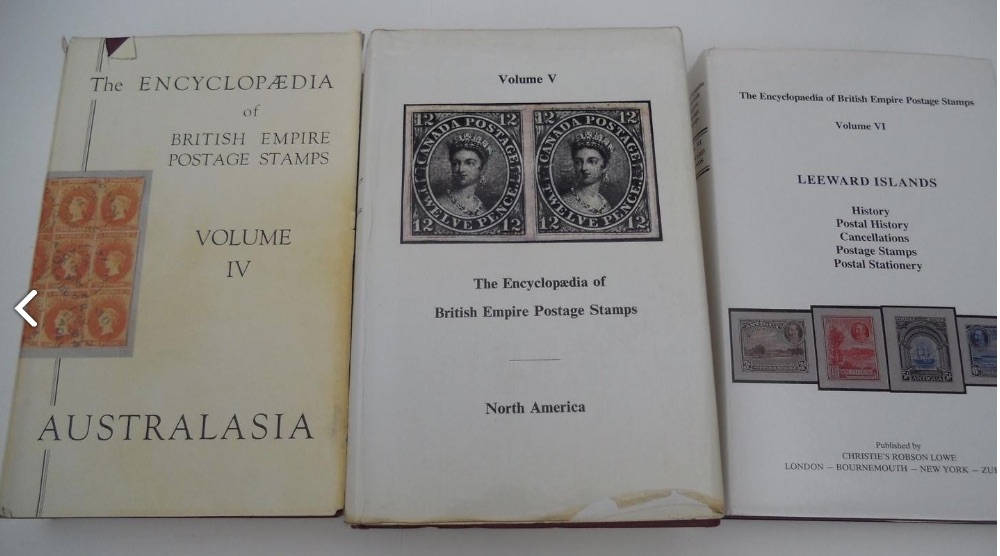Since the earliest days of stamp collecting in the 1860s to date, there have been so many great philatelists that it is almost impossible to choose the GOAT – greatest of all time. However it is certain that Robson Lowe (1905 – 1997) would find his name in any potential voter’s top three list.
Auctioneer, dealer, writer, expertiser, not to mention a collector as well, Robson Lowe was as multi-faceted a philatelic personality as there has ever been. Interested readers may refer to Dr. Stanley Bierman’s two-part biography of the man in the Quarter 1 and 2 issues of The Philatelic Literature Review.

As far as his writings is concerned, “Robbie”, as he was affectionately called by his friends, is known for publishing The Philatelist, one of the best stamp magazines of its time, as well as editing it from its beginnings in the 1930s to the 1970s. However he is probably more famous across the world for his magisterial six-volume The Encyclopaedia of British Empire Postage Stamps (Figure 1). Published between 1948 and 1991 they are arguably the most read philatelic books ever; particularly the first four volumes.


This blog is about the relative scarcity and prices of the six volumes. The first remark I would like to make is that despite being many decades old, these books are still quite useful and in demand and hence, unlike many other books in this internet age, never sell cheap.
Current dealer-quoted prices of the volumes in descending order is:
- Australasia – perhaps £75-85 for a copy in G/VG condition
- Africa and Asia – perhaps £45-60
- British North America Special Edition – £40-45
- Leeward Islands – £35-40
- Great Britain and Europe Second Edition – £25-30
- British North America – £20-30
- Great Britain and Europe Second Edition – £10-15
Africa contains information for many well-collected countries and hence sees good demand. Asia is sought after for the main reason that India and some other countries covered have not seen as much original research in certain areas. Further these two volumes were printed in lower quantities than some others. Leeward Islands was published not so long back and perhaps not that many copies have come back to second-hand market. British North America covers Canada and its provinces only and hence is not as popular. Finally Great Britain ranks towards the end since much original research has been published on it over the last 70 years or so.
Now it is frequently mentioned by dealers that Australasia is the rarest of all the titles in this series. So does that mean that the Australasia volume was printed in lower numbers than the others?
In a letter to the Editor published in Q2 1992 issue of The Philatelic Literature Review, Jim Ryan mentions the printing quantities of the Encyclopaedia; he received these details from Robson Lowe himself.
| Volume | Year Published | Nos. Printed |
| G.B. and the Empire in Europe | 1948 Jan (First Edition)* | 4,000 |
| -do- | 1952 (Second Edition) | 4,000 |
| The Empire in Africa | 1949 Mar | 2,000 |
| The Empire in Asia | 1951 Jun | 3,000 |
| The Empire in Australasia | 1962 Feb | 4,000 |
| The Empire in British North America | 1973 Regular Edition | 3,500 |
| -do- | 1973 Special Edition (two volumes with slipcase) | 500 |
| The Leeward Islands | 1991 | 2,000 |
* Corrected and reprinted in March 1948
As can be seen, quantities printed of the Australasia book is the highest (along with G.B. and B.N.A.) in the series. So it begs the question: why are they termed scarce and consequently priced higher?
There could be two theories. One is that they are indeed scarce for some reason; perhaps many copies have been destroyed or pulped. So there is a ‘supply issue’. Second is that someone started the adage sometime in the past and it has persisted into the present.
I think both these reasons may be to blame, to a greater or lesser degree.
What is surely scarce is finding these books with their dust jackets. While the final two volumes almost certainly have their dust jackets on, perhaps only 10-20% of the first four volumes are so lucky. Further the jackets are more likely than not to be in poor to fair condition only.
One reason for this is that these jackets were printed on not-so-thick paper and are fragile. Further these books are so good and so intensively used by their owners that the dust jacket suffer and are subsequently removed.
That’s quite a shame since the dust jackets add quite a bit of charm to these books. There can be a price difference of 25-35% between the same title with and without a dust jacket.
Acknowledgement: I thank Casper Pottle of HH Sales for his inputs especially with respect to current prices. The final decision on prices mentioned was however mine.







